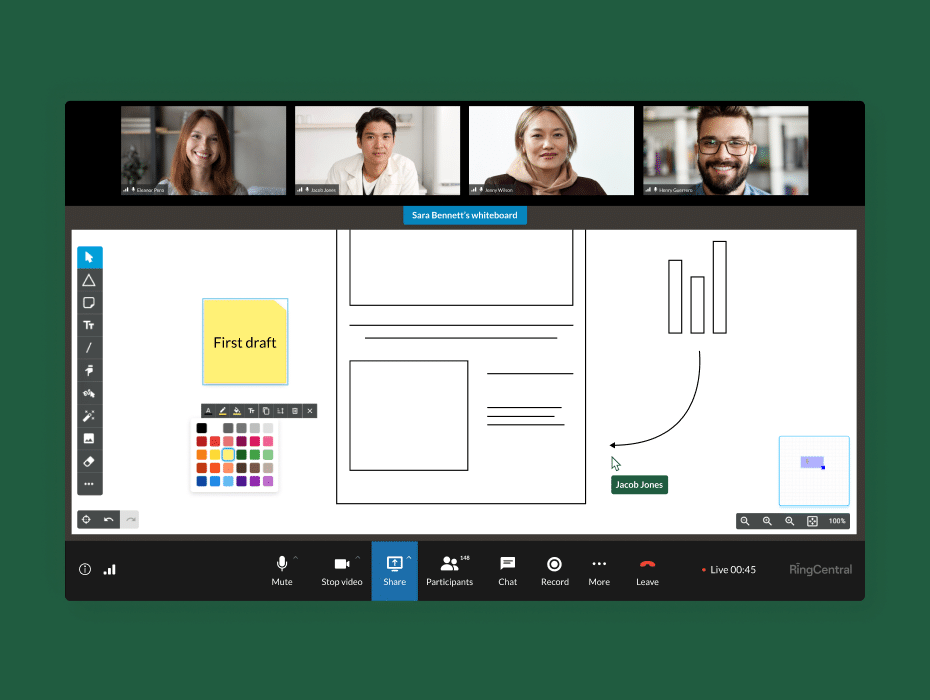Businesses of all shapes and sizes are implementing and embracing cloud strategies to drive growth and boost revenues. Today, 85% of businesses are already using cloud technology to store information, and Cisco predicts that 94% of the global workload could be processed in the cloud by 2021.
In today’s digital world, the cloud is changing the way people communicate, collaborate, and do business. It has driven innovations in the Internet of Things (IoT), devices, healthcare, autonomous vehicles, mobile applications, and machine learning. Moreover, it’s changed business telecommunications forever.
⭐ What is UCaaS? ⭐
Everything you need to know about unified communications. For beginners.
In this article, we’ll dive into the world of cloud communications to unpick what this term incorporates and how it can streamline business processes and drive success. We’ll cover:
- What is cloud communications?
- What is a communication platform?
- What are the typical communications used in cloud computing?
- What is Unified Communications as a Service (UCaaS)?
- Benefits of switching to a UCaaS business communications platform
- The future of cloud communications
What is cloud communications?
Cloud communications are internet-based voice and data communications tools for businesses to manage applications, storage, and switching—all hosted by a third party on the cloud.
Businesses can outsource systems management responsibilities like switching, provisioning, and data storage and security to cloud communications providers.
This does more than simply reduce costs (although this is a huge plus!). It also delivers advanced features and functionality that enable employees to communicate and collaborate in ways—and places—they never thought possible.
What is a communication platform?
A business communication platform is a tool that enables businesses and organizations to improve workflows and share information in real-time through the cloud. These platforms allow co-located and remote teams to collaborate and communicate instantly via team messaging, video conferencing, and/or phone.
How do communication platforms work?
Once connected, the user is added to a group or team where members can send text messages, share files, and work on projects with synchronous communication. Moreover, they can integrate business apps into a single platform to optimize productivity and efficiency.
A robust communications platform, Glip by RingCentral facilitates teamwork and communication regardless of where teams are located, with free HD video and voice quality and video conferencing, screen sharing, and IM. Moreover, it features calendar integrations with Microsoft 365 or Google Workspace for enhanced productivity and a synchronized work environment.
What are some common communication platforms?
There are countless communication and collaboration solutions on the market. Some examples include:
- RingCentral
- Google Workspace
- Microsoft Teams
- Slack
- Salesforce

What are the typical communications used in cloud computing?
Below are some of the typical enterprise communication solutions available under cloud computing.
VoIP hosted private branch exchange (PBX)
Previously, cloud services were data-centric. However, the evolution of voice over internet protocol (VoIP) has made cloud phone systems part of the package.
Traditional call centers as we know them have definitely seen their heyday. As the business world adapts to technology trends and the global shift towards remote work, VoIP phone systems provide a flexible and robust solution that enables dispersed teams to stay connected across geographical borders and deliver integrated and seamless customer experiences.
How does cloud telephony work?
VoIP service providers route business phone calls by converting analog voice signals into data packets. Businesses install SIP trunking to enable the sending and receiving of calls via an IP network. Essentially, a cloud PBX allows users to make and receive calls over the internet.
Users can communicate with colleagues and customers with a single click using any internet-connected device like a softphone, computer, tablet, or smartphone. Business owners can manage their cloud-based contact center with an online dashboard that provides control over phone numbers, adding and removing users, call monitoring, and more.
The benefits of cloud telephony for businesses are numerous. Some key advantages of a cloud-based communications system like RingCentral include:
- Cost-efficient: Reduces costs associated with installing and maintaining conventional on-site business phone systems and the equipment they require (eg. handsets, copper wiring, call center hardware, etc).
- Mobile: Access complete phone system functionality from anywhere with internet connectivity. Users can make calls, listen to voicemail and fax messages, or view caller activity anytime, anywhere.
- Flexible: Employees don’t have to be in the office anymore, they can make and take calls remotely from a computer or mobile device.
- Scalable: A cloud phone system can grow as your business grows. Businesses can easily add or remove lines to suit their needs, and monthly payment plans keep costs manageable for growing small businesses.
- Productive: Calling features such as auto-attendant, IVR, call forwarding, and call recording can boost agent productivity and enable customer service teams to communicate effectively with colleagues, business partners and customers.
Video conferencing
Video conferencing is a method of communication made possible by internet telephony. In today’s world of dispersed teams and a remote workforce, the ability to communicate with face-to-face video calls is invaluable.
Unlike phone calls, video lets participants fully express themselves. Real-time video conveys all the emotions, expressions, and tonality that an in-person meeting would. RingCentral Video offers conferencing features like screen sharing and screen recording, which boost productivity by making it easier for teams to collaborate.
What’s more, with VoIP solutions available on mobile devices, teams can communicate and collaborate by joining video meetings on-the-go from anywhere in the world. Joining a meeting is simple, all it takes is a single click.
Whether your team has been remote for a while or has recently shifted in response to COVID-19, video meetings fuel meaningful interactions and boost employee engagement among dispersed teams.

Messaging and business SMS
Text chat and Business SMS allow businesses to send and receive text messages between teams, customers, and departments using their business phone number. This method of communication is useful for sharing information quickly, without having to initiate a phone/video chat.
Business communications solutions offer team chat so employees can discuss projects and tasks efficiently. Moreover, switching between a text chat and a phone/video meeting is simple, as all your communications needs are in one place.
File sharing
Data storage, sharing, and backup on the cloud provide increased security and collaboration capabilities for both co-located and dispersed teams.
With cloud-based file sharing and storage, teams can access data and project resources instantly via a continuously updated database. This is particularly beneficial for teams collaborating remotely who might be located in different time zones, as there’s no need to rely on inefficient email chains to get the answers or information required.
Importantly, cloud storage improves business continuity as data and files remain backed up and safe in the cloud, even if a disaster strikes or there’s a system outage.
What is Unified Communications as a Service (UCaaS)?
UCaaS is one of the most comprehensive cloud communications solutions. It’s a specialized Software as a Service (SaaS) solution that enables businesses to replace their legacy phone systems with a system based in the cloud.
These platforms provide businesses with a fully functional and unified communication infrastructure hosted on the cloud. With 68% of UCaaS buyers reporting that all-inclusive capabilities are crucial to their purchasing decisions, it’s clear that convenience is one of its major benefits.
A UCaaS solution like RingCentral Office allows end users to tap into a single communications platform and access:
- Shared infrastructure (eg., data centers and storage)
- Network management tools
- Real-time communication (video, voice, message, social media, etc)
- Non real-time communications (email, fax, voicemail)
- Call center features (call routing, call forwarding, etc)
The best part? Businesses can access all the features of a complex platform that unifies communications, without having to manage and maintain it. The siloed nature of on-premises PBX systems means less cost visibility. Unified business communications platforms are hosted by third-party providers who own and maintain the servers, so you just pay for what you use!
Cloud access and storage provides greater availability, flexibility, and scalability for businesses. Moreover, employee productivity soars when users can access all of the tools and business applications they need from one familiar interface for a streamlined user experience.
Benefits of switching to a unified communications platform
Not all enterprise communications platforms are created equal. Some offer greater functionality, others might be targeted at call centers, whereas others still may be aimed at enterprises.
So, what are the benefits of switching to a unified communications platform?
Improved flexibility and productivity
With a UC platform, businesses can access a host of communication services from a centralized location.
An integrated system means employees can enjoy the flexibility of various platforms and the ability to seamlessly switch between them. Not only does this provide convenience, it also boosts employee productivity as employees spend less time switching between platforms and struggling to communicate with other members of their team. Open APIs allow for comprehensive integrations with all your favorite business apps.
According to a study by Evolve IP, 72% of respondents said that UC services led to improved productivity, 91% reported better collaboration, and 88% agreed it resulted in faster problem-solving skills.
RingCentral Office combines synchronous and asynchronous communications for a robust platform that enables users to connect and collaborate across multiple channels and devices.
Tap into a remote workforce
With RingCentral Office, businesses can simulate a virtual office environment that enables employees and teams to connect, collaborate, and work from anywhere, as if they were in the same place.
COVID-19 forced 88% of organizations worldwide to go fully remote or to encourage their employees to work from home. This quick shift required business operators to think of innovative solutions to keep operations running smoothly. Many discovered that a unified communications solution provided many advantages in a post-pandemic workplace.
According to a study by Harvard Business Review, remote workers are more productive and happier in their jobs. Remote working is one of the main factors driving UCaaS growth as businesses across industries align with the global shift towards remote work.
Whether someone is working from home, a coworking space, or a country halfway across the globe, they can enjoy integrated cloud communication and collaboration tools with the RingCentral app for desktop or mobile devices.

Cost savings
RingCentral Office offers a cost-effective solution for businesses. Not only does it take away the costs associated with the on-premises hardware and maintenance of legacy systems, it also reduces the need for business travel and the costs of long-distance business calls to landlines.
Moreover, RingCentral is available as a pay-as-you-go subscription model. This means you just pay for what you use, avoiding all the hidden costs of inflexible analog phone systems. All you need to do is make sure you have enough internet bandwidth to ensure the platform operates smoothly.
You can start small with a basic plan, and expand your platform as your business grows.
Scalability
One of the main goals for every business is growth. Unified communications provides a solution that can grow as your business grows. You can’t be certain where your business will be in a few years, or predict how many phone lines you’re going to need once your business starts to grow.
Flexible solution providers like RingCentral can adapt and scale up or down as your business needs change. It allows you to make changes from a unified dashboard, so you won’t have to rely on your service provider to add new numbers or deploy IT professionals every time you onboard new employees. This way, UC can benefit users and IT departments alike.
With a RingCentral unified cloud communications platform, you can enjoy access to unlimited call capacity and a fully scalable system that can adapt to your needs in periods of growth.
Enhanced data security
All of your business and customer data is housed in secure tier-one data centers. These security measures are greater than those offered by on-site legacy systems as they’re managed by a highly-skilled third party who understands the ins and outs of data security and regulatory compliance.
This provides a huge advantage for small businesses without large IT departments or businesses spread across multiple locations. RingCentral security promises complete transparency and extensive measures at each level of system architecture and infrastructure.
The future of cloud communications
In today’s age of digital transformation, a business model based in the cloud just makes sense. Cloud communications is more than just cloud telephony, hosted PBX, or UC. It’s a whole new way of building, deploying, and scaling business communication systems.
As technology trends continue to shift, and the global workforce becomes increasingly remote, the need for communications services that transcend the traditional limitations of legacy systems is more significant than ever.
As we look to the future of cloud-based communications, we’re likely to see more mobilization, enhanced customization opportunities, and increased functionality to align with developments in business needs. One thing’s for sure, the cloud shows no signs of slowing down.
Originally published Jan 08, 2022, updated Oct 10, 2023





